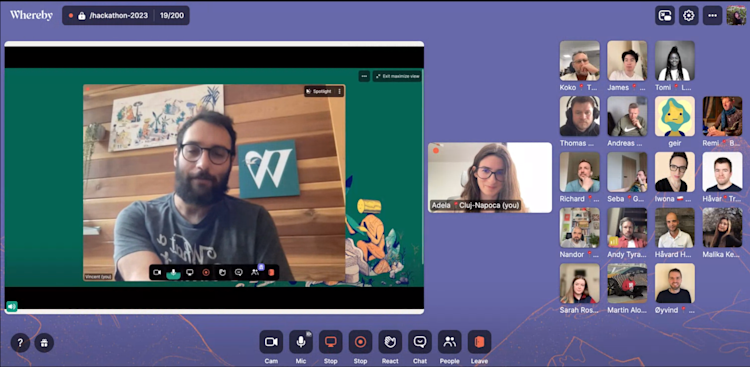How We Use Hackathons to Connect, Team Build and Innovate
Discover how the Whereby team run hackathons across the entire company and read some tips on how to run your own for team building and innovation.

At Whereby, we’re a fully remote, distributed team. We have team members spread across the globe from Norway to Chile and fully embrace our mission to create a world in which anywhere works. But how do you foster innovation, creativity and collaboration in a remote setup? It can be challenging to generate ideas and invent from afar. We’re always looking for new methods and techniques to inspire and empower our team. One way we’ve found successful to focus and innovate is running hackathons, and every year we organize at least one.
We recently hosted a week-long company wide hackathon, read on to discover how we did it and how you could too!
What is a Hackathon?
A hackathon is an event where people come together to collaborate on a project, often using technology, with the goal of creating something innovative and useful in a short space of time. It can be for a day or a whole week, but the idea is that as far as possible the team focus on getting creative and collaborating. We choose to add a competitive element with awards given at the end of the hackathon for the “People’s Choice” and “Executives Choice” for the best project.
While hackathons are often associated with tech companies and tech-savvy individuals, hackathons at Whereby are always company-wide. We believe that innovation can come from any department and you don’t need to be tech-savvy to propose, participate or win the hackathon.
Benefits of Hackathons for Remote Teams
Hackathons provide an opportunity for people from different departments to work together and share their skills and expertise. Everyone shares a common goal and learn both together and from each other during the course of the event. It’s a great way to help teams build relationships, share knowledge and innovate.
This kind of event is also an opportunity for people to work on projects they are passionate about and have fun while doing it. This is an incredible morale booster and can create a sense of camaraderie and team spirit, which is, of course, valuable for company culture and retention.
The projects are not only fun to work on, but are often surprising and amazing investments in the future. They can be anything from improving company processes to exploration of new features to improve products or services.
And this is exactly what happened in our most recent hackathon!
We were so impressed with the innovation, creativity and usability of the projects our team came up with, and we are very eager to show you some of them in the near future as they get added to our product roadmap and developed further.

How do you Organize a Hackathon?
Set Goals
When hosting any type of event, including a hackathon, is important to understand your goals. For us, the goals were: innovation, relationship building, a boost in morale, and to have fun.
Because of this, we decided on a week-long event and a broad theme for our most recent Hackathon.
Having a week-long event helped us have bigger goals when it came to innovation, helped with creating meaningful relationships between team-members and it was also refreshing for the team to have a whole week focused on something new and different. If a whole week isn’t possible for your business, you can tighten the scope and have narrower goals so that you can run a shorter event that still has valuable outcomes.
Set Expectations
There will of course be day-to-day activities vital to the running of your business. Holding a hackathon doesn’t mean shutting down for a week and ignoring your customers! During our hackathon, we continued to help customers and had team members available for any urgent issues. But many other projects were temporarily paused to make space for brainstorming, experimentation and creation.
Set a theme
We always like to introduce a theme to generate ideas. Having a wide theme keep ideas unbounded and lets people choose to work on what matters most to them. Depending on how long your hackathon is, pick a theme that is both broad enough to spark creativity, but niche enough to produce valuable and useful outcomes that can be expanded upon in the future.
Create a structure
There is no one way to organize a hackathon, but as a distributed team we value having a large chunk of the planning executed asynchronously, ahead of the hackathon kick off. This means that the time that we do spend together (virtually, in a Whereby room of course!) is more valuable and not spent on admin tasks.
How do you run a Hackathon?

Here are the steps we take to get set up for success and ensure a smooth hackathon:
Before the hackathon
A couple of weeks before, we open an async list (we like Notion!) where people can input their project pitch/ideas and start gathering a team. The list is open to everyone, both to pitch projects and to join the already pitched projects. They don’t need to be fully formed projects at this stage, just loose ideas to get things started.
Time to hack!
We start the Hackathon week with a kick-off call, where we pitch all the projects. Being a remote company, we also have teams presenting their project async (with pre-recorded videos) if they are unavailable or in a different time zone.
After the kick-off, everyone picks their team and the projects they would like to work on.
Teams get started working on their ideas, hacking together to see how they might bring the concepts to life. They independently set up Slack channels and huddles to coordinate their work however works best for them.
Mid-week, all the teams come together for a fun catch-up where they eat lunch together, share progress and play a couple of rounds of your favourite game (We love GeoGuesser!)
At the end of the week, it’s time for the demos! Everyone comes together to show what they achieved. As with the pitches, we hold the demos in a combination of sync and async to accommodate the entire team’s needs. The call is recorded to be shared with everyone straight after in case they weren’t able to join live.
After the demos, the whole team votes for their favourite project. In our most recent Hackathon, we had two different awards: People’s Choice and the Executive’s Choice. For People’s Choice, voting was open to everyone in the company to select their favourite. For Executive’s Choice, our Executive Team selected which project they thought was the most impressive, innovative and impactful.
To round off the week, the two awards are announced and presented to the winning teams. The prize could be anything from a piece of tech, a voucher, some merch, a free lunch or anything you like!
What happens after the Hackathon?
As you will only have a limited time for the event, there will inevitably be projects that are either not finished or they will need some more work to be transformed from MVPs to fully working features.
To make sure these great ideas aren’t lost, make sure to discuss all the projects at the end of the hackathon and make conscious decisions regarding what’s next for them. That could be putting them on the roadmap (if they’re bigger projects), putting them directly in the backlog with a determined priority (if they’re smaller) or even deciding to continue them right away. Not everything will be taken forward into production but it’s important to make sure the projects that can have an impact on your business or be great new features don’t get forgotten once the hackathon is over.
Hosting a company-wide hackathon has proven a valuable investment for our company. It has fostered innovation, encouraged learning and growth and built team spirit and morale. We’ve had some amazing projects begin from hackathons in the past (like our Hybrid Meetings feature and a Volunteering Programme) and we can’t wait to share some of the incredible features and initiatives from our recent and future ones with the world!


